Ashadh Krushna Shashthi, Kaliyug Varsha 5112
Some years back, a friend who had gone to Indonesia, the most populous Muslim country in the world, on his return met me at Adipur in Kutch (Gujarat) and showed me a high-denomination (20,000 rupiah) currency note of that country with Lord Ganesh imprinted on it. I was as surprised, as I was impressed.
When last month a group of eminent Sindhi gentlemen came to Delhi from Jakarta, the capital of Indonesia and invited me for a World Sindhi Conference scheduled to be held at Jakarta on July 9 to11, 2010, I readily agreed. One reason was that I had never before been to that country, though I had often heard reports about the impact of Indian civilization and more particularly, the impact of epics like Ramayana and Mahabharata on that country. The Ganesh inscribed currency note was only an example.
Accompanied by my wife Kamla, daughter Pratibha, my associate for decades, Deepak Chopra and his wife Veena, I left for Indonesia on July 8 and returned on July 13 with very fond memories of the trip. Indonesia comprises 13,677 islands of which over 6000 are inhabited. Of its total population of 20.28 crores, more than 88 per cent are Muslims, and 10 per cent Christians. Its 2 per cent Hindu population is concentrated mainly in the island of Bali, the famous tourist paradise.
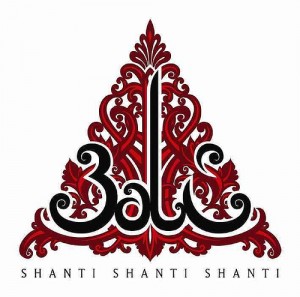 Brand logo of Bali |
The recently adopted above new brand logo for the Island of Bali is a manifestation of country’s Hindu traditions. An Indonesian Ministry of tourism publication explains the logo as : The triangle (shape of logo) is a symbol of stability and balance. It is formed out of three straight lines in which both ends meet, taking the symbols of a blazing fire (Brahma – the creator), lingga or phallus. The triangle also represents the three Gods of the universe (Trimurti – Brahma, Wisnu, and Siwa), three stages of nature (Bhur, Bwah and Swah Loka), and three stages of Life (Born, Live, and Die). The tagline ‘Shanti, Shanti, Shanti’ represents peace upon Bhuwana alit dan agung (yourself and the world) that will deliver a sacred and holy vibe that awakens a deep aura that balance and make peace to all living creatures.
Also given below is a specimen of the Ganesh-inscribed 20,000 rupiah currency note of Bank Indonesia. As I have mentioned in this piece earlier, I had seen this some years back and had resolved then itself to procure a specimen of the note to show it to others if I happen to visit that country.
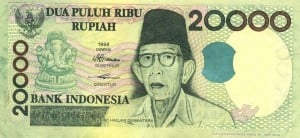 Indonesian Rupiah with Ganesh Inscription |
The Sindhi Conference was a great success. More than a thousand delegates drawn from 32 different countries of all five continents – America, Europe, Asia, Africa and Australia – attended the conclave. Most of the delegates were youngsters or middle aged whose families had gone through the sufferings of mass migration which happened in 1947.
Partition of India had dealt a terrible blow to millions on both sides of the Radcliffe Line. Hindus from Sind had not only been uprooted from their hearths and homes, but unlike Hindus of Punjab and Bengal, who had the satisfaction of saving something like half of their home states, had also been despoiled off their entire province, and forced to adopt different states of divided India as their totally new homes.
Speaking to these Sindhi delegates I felt proud that they had not only gone through the traumatic experience of partition with confidence and fortitude, but, generally speaking, they had actually prospered immensely. They had succeeded in converting a calamity into an opportunity.
Of course, there were in this gathering delegates whose forefathers had gone to the countries they represented in this conclave, long before India became independent and suffered this trauma of partition.
The main organizer of this Jakarta Conference for instance,Shri Suresh Vaswani was one whose grandfather had come to Jakarta some time around 1914, that is, nearly one century back! This family had since settled down here and made this island of Java their home. When we were in Sind, this class of traders who went overseas and earned wealth for their families were colloquially known as ‘Sindhworkies’.
For a visitor to Jakarta, Indonesia’s capital, situated on the north-west coast of Java, the most striking landmark right in the centre of the city is the magnificently-constructed Shri Krishna-Arjuna pair mounted on a multiple -horse-drawn chariot.
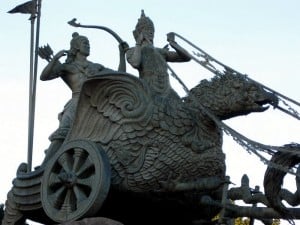 Krishna-Arjun statue at Jakarta main square |
In Indonesia, the names of places, of people, and the nomenclature of institutions also give one a clear impression of a benign Sanskrit influence.
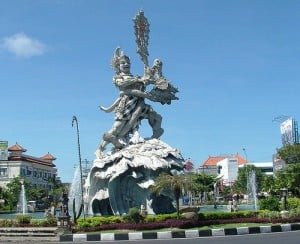 Statue of Bheem |
It certainly pleased me to gather that the official mascot of Military Intelligence in Indonesia is Hanuman. The rationale offered by a local was that it was Hanuman who had been able to trace that Sita, kidnapped by Ravana, had been kept in confinement at the Ashok Vatika.
Our family spent four days in Indonesia – two days in Jakarta and two days in Bali.
Bali is one of the bigger islands of the country. Its industries include gold and silver work, woodcarving, weaving, copra, salt and coffee. But the moment you touch the place you can see clearly that the place is swarming with tourists. With a population of around three million, Bali has a tourist traffic of around one million every year.
The capital of this island is Denpasar. Our place of stay was the picturesque Four Seasons Resort, a seaside resort not very far from the airport.
On way to the Resort I saw a gigantic stone construction not very dissimilar to the Krishna-Arjuna one I had seen in Jakarta, except that this one was bigger.
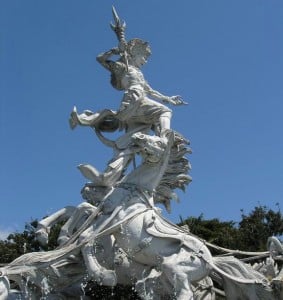 Ghatotakach Statue near the Ngurah Rai International Airport |
I asked the driver of my car: Whose statue is this? And you can imagine my surprise when he replied: “This is a depiction of Ghatotkachof the Mahabharata.” He added; “And the statue in the city itself showing Ghatotkach’s father Bheema waging battle with a demon is even more massive!”
In India itself, of the two epics Ramayana and Mahabharat the average citizen is familiar with most characters of the Ramayana. But the characters of Mahabharata are little known. Indeed, even in India very few would be able to identify who Ghatotkach is. And here was the driver of our car knowing full well both Ghatotkach as well as his relationship with Bheema!
Both at the Sindhi Convention in Jakarta as well as in Bali we were able to witness glimpses of scenes from the Ramayana enacted with slight variations from the traditional form as known to us in India. The performance, the presentation as also the general climate at the sites where the shows were held were all marked by befitting piety and reverence.
Indonesia, I must say, seemed to know and cherish Ramayana and Mahabharata better than we do.
Source: Haindava Keralam
Also See
 |
Hang terrorist Mohd AfzalMohammad Afzal.is a Kashmiri terrorist who attacked parliament in 2000. Supreme court has given death sentence but congress is protecting this anti-Indian. |
 |
Hindu Genocide in Kashmir & Bangladesh
Online photo exhibition of Hindu genocide and temples destruction in Kashmir by local Muslims. Series of exhibitions being arranged. |




